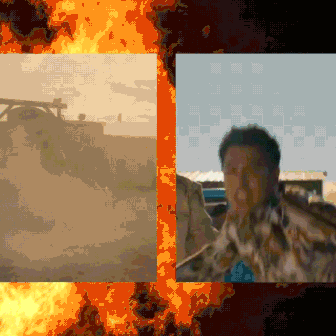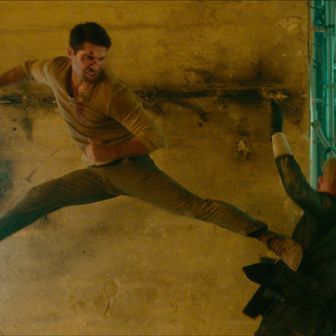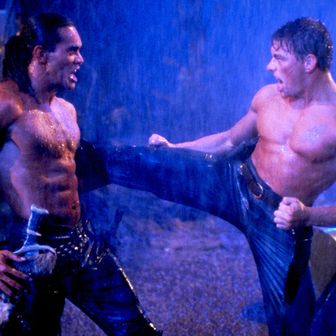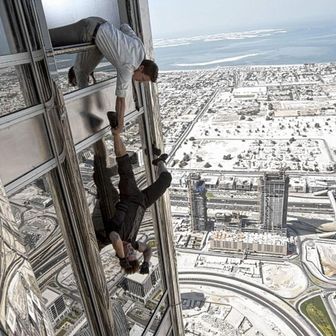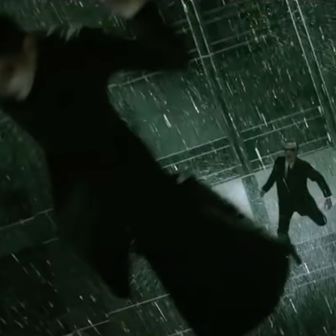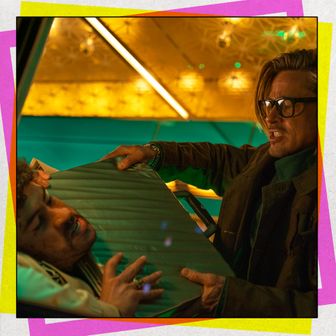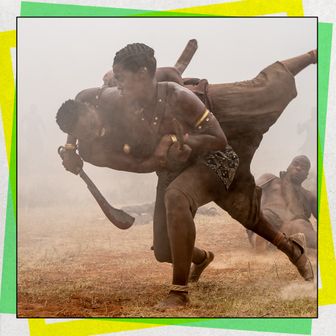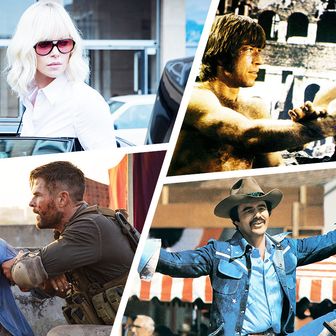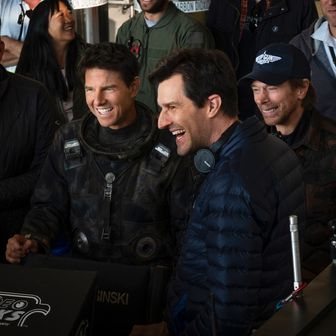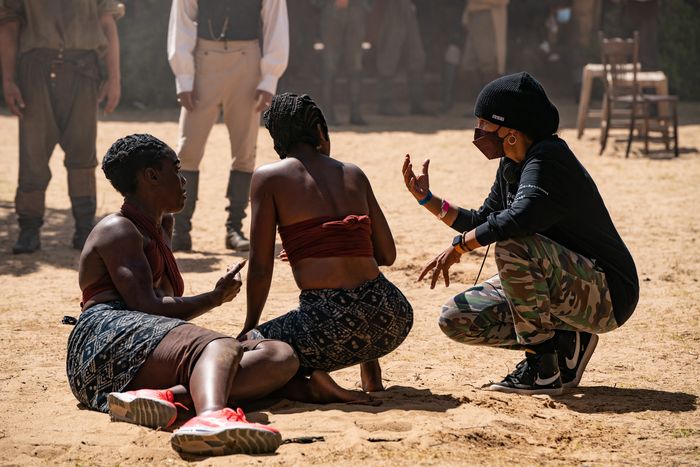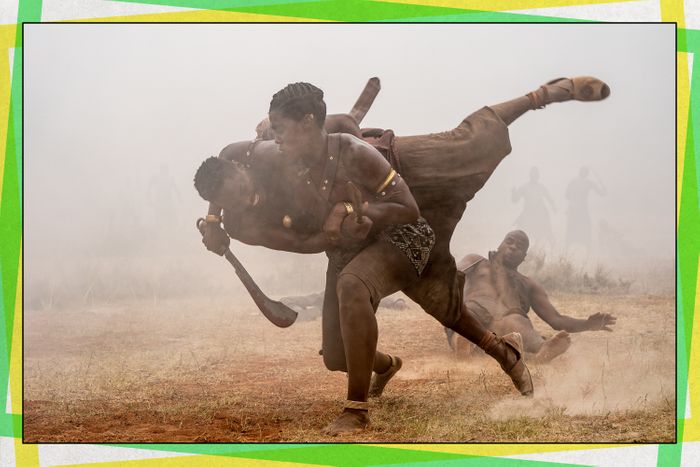
After starting her career with romantic dramas such as 2000’s Love & Basketball and 2014’s Beyond the Lights and the literary adaptation The Secret Life of Bees in 2008, Gina Prince-Bythewood dove into the action genre with 2020’s The Old Guard, an inventive, beatdown-filled comic-book adaptation for Netflix. Her latest film, The Woman King, is a step further in that direction: released last year to solid box office and glowing reviews, the movie is a highly personal and intimate story about culture clash, mothers and daughters, and how the past haunts us. It also happens to be a gonzo action movie filled with amazing stunts. Following The Woman King’s nomination for a Vulture Stunt Award, we asked Prince-Bythewood to tell us about some of the film’s most remarkable sequences.
Most complex action scene
I had to shoot the entire Oyo battle in 11 days, and I remember wondering, How is that going to be possible? Danny Hernandez, the incredible fight and stunt coordinator I met making The Old Guard, is a genius, and he was my second call after Terilyn Shropshire, my editor. I said, “Danny, you’ve got to come.” I knew I wanted the women to do their own stunts and fighting, and I felt like he could get them there.
The Oyo battle is broken up into vignettes. We have the overall crush of bodies and armies, but there are individual moments throughout. For them, Danny would use stunt people to demonstrate the action, then I looked at it and gave notes. When he showed me some female warriors jumping off the backs of male warriors and landing in the crowd, it was just so dope, my reaction was immediate: “Absolutely! That’s amazing. That’s going to be the centerpiece.” But then I said, “I really want our actors to do it.”
I thought it made the most sense to have Lashana Lynch and Adrienne Warren do the stunt, but there was so little time for them to learn and rehearse it. You’re running at full speed, stepping on a guy’s back, and leaping in the air with a machete. Not a little rubber machete but a real (unsharpened) machete. Then you’ve got to land and immediately start fighting.
I pushed the scene to the end of the shoot, because I wanted the actors to be in peak condition and have a comfort in doing their own fighting and stunts. By the time we got there, they had the mentality of Give me harder and harder stuff. They were addicted.
I went to Adrienne first. As soon I showed her, she was like, “Fuck yeah, I want that.” She used to play ball, so I knew that she had hops. It took them about an hour to teach her. That night, I called Lashana, who had the most stuff to do in the Oyo battle and had already been training. I explained the stunt to her, and she was quiet for a moment. Then I said, “Adrienne learned it in an hour.” As soon as I said that, she said, “Okay, I’ll do it.” I knew her competitiveness! So the next morning, while we were shooting other stuff, she was learning the stunt. And she had about an hour to do it.
It was nerve-racking. The timing is so precise: You’re running at full speed, you land on their back, and at that moment, the men have to buck up their bodies to launch you in the air. You need to have complete trust in the guy you’re stepping on, whom you’ve just met. I put Lashana and Adrienne next to each other, because I knew they’d be competitive about who could jump higher. But what if they land wrong? What if they slip off the back? These warriors are oiled up with palm oil. Lashana was already sore, because she had a foot issue, but they just wanted to do it.
We had to do at least 14 takes to get the timing right. On about the tenth one, Adrienne landed wrong. As a director and a friend, you see somebody go down and your heart sinks. I ran over. She gets up limping. And she’s like, “Let’s go again.” I was like, “Okay, wait a second. Let’s check.” “No, let’s go! Let’s go, let’s go!” That was the mentality. So we did it again and finally got that perfect one. Then the two of them came separately to me asking who jumped higher.
The stunt that made her most nervous
It’s not the technical that scares me. It’s the personal. In the montage scene of them training, I have Lashana flipping Thuso Mbedu. And it’s not a little flip. The ground was padded, but you’re always conscious that you’re putting your actors in a position to get hurt. Stunt people get hurt, and an actor might get hurt too.
Another one that scared me was in the opening scene of the enemy village, when Sheila Atim jumps off of Lashana’s back while they’re right by a fire. Yes, we had somebody right there. If something happens, that fire goes out immediately. But Lashana’s back was oiled, and they were still getting used to that stunt. You have to do it over and over until you get it right, but you’re getting more tired every time you do it. So my heart was just a knot until we got it.
The actor most excited about stunt work
It truly is a tie between Lashana, Thuso, and Sheila. They kept wanting me and Danny to up the difficulty, and they trained incessantly during the shoot. That’s something important I learned on The Old Guard: You have to keep training. We’re shooting five, six days a week. Then these women would then come in on Sunday — we call them “Sneaky Sundays” — and continue to train. If you went by Sheila’s apartment at any time, if she wasn’t shooting, she had that spear and was on her porch constantly working. Thuso, with that rope gag, was in front of her trailer constantly figuring it out. And again, Lashana — she just wanted more. She was the one who came in with some experience with stunts from No Time to Die. But she’ll say that nothing prepared her for this.
Biggest unexpected challenge
Our budget did not allow us to bring in stunt people, so we had to literally create a stunt team in South Africa. I give such credit to Danny, but also to Grant Powell, who was our South African stunt coordinator. He was in charge of building out the Agojie warriors, the women, then the men they were fighting against. Grant went to dance studios, martial-arts studios. He went after athletes, soccer players, netball players: searching for women who were athletic and testing them. Then they went to a boot camp for months in the same way our actors did. There were about five women who had some stunt experience, but everybody else became stunt folk. That was the most intimidating at first, knowing we had to do that. Then I got on the ground and saw these men and women working so hard and their desire to be part of this project. And now I’m proud, because South Africa has a whole stunt community of Black performers that it didn’t have before.
Best stunt lesson learned making The Old Guard
Foremost, Danny. The beauty of the way Danny and I work is we start every conversation about an action beat with a character. And what is it saying about the character? How does it push the story forward? So that defines fighting styles. You don’t want sameness ever. You don’t want gratuitous fighting. We know when we see that how boring it could be.
This sounds so basic, but you learn that if you do not get it on set, it will not be in the editing room. That was something I had to constantly remind myself. I remember, we were doing a stunt with KiKi Layne, and she has to get shot, roll up on one knee, then boom, take out two people — all in one fluid motion. We did it 21 times. Everyone gets tired, and people get cranky. You see the time slipping away, and your day is dying. But we had to get it right. And thankfully, KiKi had the mentality of Yeah, I’m not quitting until we get it right.
When I cast, it’s not just talent. It’s this: What is your work ethic? Because you do not understand how hard you have to work to do your own fighting and stunts until you’re in it. It is surreal how hard it is. And you’ve got to keep training throughout filming. On The Woman King, we didn’t leave anything to chance. We were in charge of their nutrition. They all were on a meal plan. You can’t be eating McDonald’s and perform at the level required.
The scene you were saddest to cut
In the original draft of the script, when Nanisca (Viola Davis) and Nawi (Thuso) jump off of the fort wall into the water, there were sharks in there — and another warrior who jumped with them got eaten! It was just so cool. It would’ve been one added level of danger of them in the water and swimming to get to that boat. But with our budget and number of days, I pretty quickly realized that it was never going to happen. I do miss that.
There’s another scene, which we did shoot. Sheila, who plays Amenza, knows how to pole dance. She can go upside down and spin around. So we used that. When the Agojie women come to rescue Nawi and decimate the slave port, there was a moment, after she beats a guy with a chain, when someone comes at her and she evades the sword by flipping upside down. Then she comes around and kicks them. We shot it, and she did it herself — it’s incredible. But when I watched it, I thought, Is this a beat too far? Is this going to take us out of the visceral environment that I wanted to create with the action? So I cut it. I felt bad about it, because she shot it and was so good.
The biggest influences on The Woman King’s stunts
My professional jealousy is Mission: Impossible — Fallout. That bathroom fight is one of the greatest fight scenes ever. I studied it before I shot the airplane fight for The Old Guard — though I learned from Danny that they shot the bathroom fight for a month, and I had five days for mine! So much of the action in that film is just next level. It’s exciting, and it’s personal. And because it’s really Tom Cruise, he inspires the other actors to be in it as well. You see the importance of performance in stunt work.
When it came to making The Woman King, we looked at Braveheart. We looked at The Last of the Mohicans, Gladiator, a couple sequences from Game of Thrones. The Raid is always something I look at, because the fighting style is so visceral. Those were the templates that my cinematographer, Polly Morgan, and I looked at just in terms of how we wanted to approach it. How do you shoot a whole battle? How you have to make sure you have a beginning, middle, and end. What is the drive? How do you feel throughout it? Where do you get the specificity? Then you watch all of these things, you take in what you feel you need, and you think, Okay, how do we make ours different? What is specific to The Woman King? It’s the style of fighting. It’s the performance. It’s the stories in the fight. It’s the stakes. That part of it was the fun of putting our own stamp on this genre that I love so much — the historical epic.
More From This Series
- And the Winners of the 2024 Stunt Awards Are …
- The Second Annual Stunt Awards Are Here
- Academy Awards Reportedly in Preliminary Talks for a Stunt Category


